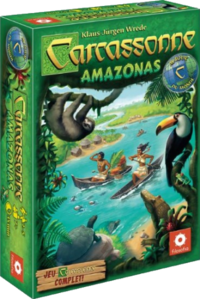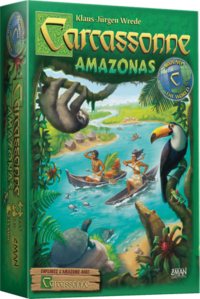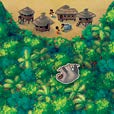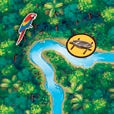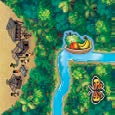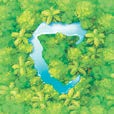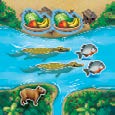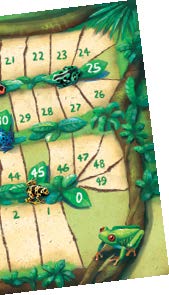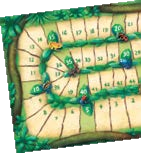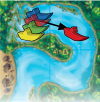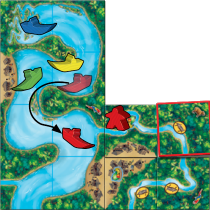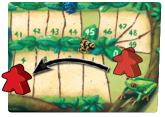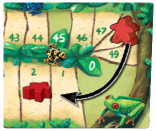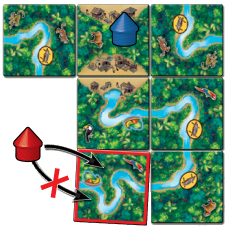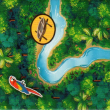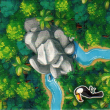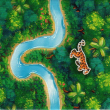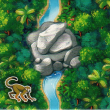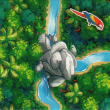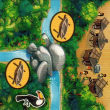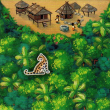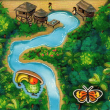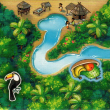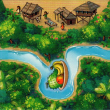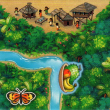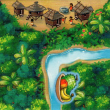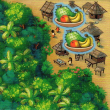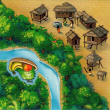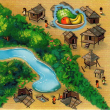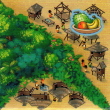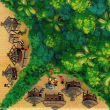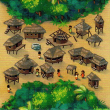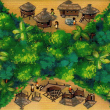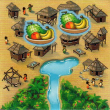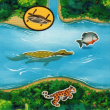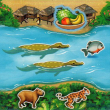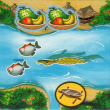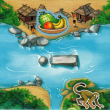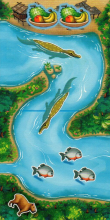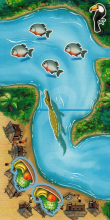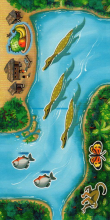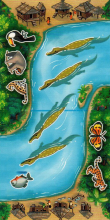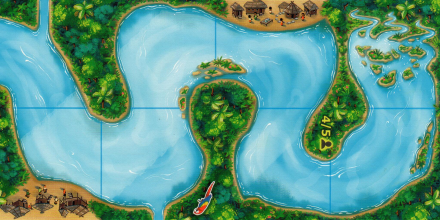Amazonas (jeu de base)
 |
Vous êtes en train de lire les règles pour ce modèle de tuiles. |  |
| Si vos tuiles possèdent ce motif, il s’agit de tuiles Carcassonne normales. |  |
| Si vos tuiles ont un motif différent, choisissez un jeu parmi les jeux dérivés. |  |
'Sous la chaleur tropicale de la jungle, vous pénétrez dans la forêt tropicale sud-américaine. La rivière et la jungle regorgent toutes deux d’une faune colorée qui crée un des plus beaux panoramas. Mais vous avez peu de temps pour apprécier la sérénité du moment, car vous remarquez que d’autres explorateurs se dirigent vers la jungle pour construire des camps et descendre la rivière. La course vers l’embouchure de l’Amazone est lancée !
Informations générales et commentaires
Amazonas a été publié à l’origine par Hans im Glück en 2016.
Matériel et mise en place
Bienvenue dans Carcassonne — AMAZONAS. Cette règle a été conçue pour vous permettre de vous familiariser le plus rapidement possible avec le jeu. Après cette courte lecture, vous pourrez enseigner le jeu et y jouer. C’est ainsi que vous explorerez Carcassonne. Tout d’abord, il vous faut mettre le jeu en place, ce qui ne prendra que quelques instants. D’ailleurs, nous allons profiter de cette mise en place pour vous présenter le matériel.
Matériel
- 65 tuiles standards sur lesquelles sont illustrés des affluents et villages entourés par la jungle où vivent toutes sortes d’animaux.
- 15 tuiles Amazone, que l’on retrouve parmi les tuiles Terrains, ont une capacité spéciale durant la partie et 4 double-tuiles Amazone.
- 1 tuile de départ d’une taille égale à 2 × 4 tuiles Terrain.
- 1 tuile Embouchure
- Plateau de score
- 25 meeples, cinq dans chacune des couleurs suivantes : jaune, rouge, vert, bleu et noir
- 10 camps, deux dans la couleur de chaque joueur
- 5 pirogues, une dans la couleur de chaque joueur
Mise en place
Mélangez les 80 tuiles Terrain (standards et Amazone) et disposez-les en piles différentes, face cachée, en vous assurant de répartir uniformément les tuiles Amazone.
Set aside the 4 Amazon double-tiles; they will come into play later. The River mouth tile is also set aside for now and will be used at the end of the game.
The board (the size of 2 x 4 Land tiles) is the start tile. Place it on the side that matches the number of players: with 2 or 3 players, there are 16 spaces; with 4 and 5 players, 8 spaces. Place the source of the Amazon River near the edge of the table. Leave enough room between the Start tile and the edge of the table for a minimum of 2 rows of tiles. By the end of the game, the river will have a length of a little over 1 meter (close to 4 feet).
Each player chooses a color and takes the boat in their colour. The last player to have gone on a boat ride is the first player (or, alternately, the youngest). Each player puts their boat on the first space of the Amazon River (the source).
Each player takes 4 meeples and the 2 camps in their color to form their personal supply
Then, each player puts their 5th meeple on space 0 of the scoreboard. Any remaining pieces are returned to the box
Aperçu et but du jeu
Before diving into the rules per say, you should know what the goal is in Carcassonne – Amazonas. One after the other, players will place tiles. This is how, one tile at a time, you will discover features (villages and tributaries), the Amazonian jungle, and the Amazon River itself. You will place meeples in villages and tributaries, and your camps in the jungle. At the same time, you will want to move your boat down the Amazon River to get ahead of the other players. You will score points during and at the end of the game. After the final scoring, the player with the most points is declared the winner. Let’s get started!
Déroulement de la partie
A game of Carcassonne – Amazonas is played in clockwise order. Starting with the first player, the active player does the following actions in the order listed below, followed by the next player, and so on and so forth. We’ll first give you a brief description of the actions you must do during one of your turns. These actions will be detailed as we present the many aspects of the tiles.
Le fleuve Amazone et les règles de placement d’une tuile Terrain
Les deux règles de placement de tuile les plus importantes sont :
- La tuile que vous placez doit continuer le paysage (les illustrations), et
- Vous ne pouvez pas placer de tuiles Terrain standards au-delà de l’embouchure du fleuve.
Initially, there are 10 possible Land tile placements. Once a tile has been placed, you can place other tiles next to it.
The Amazon River also plays an important role in tile placement. At first, the river is only on the Start tile, but you will soon extend it with Amazon tiles, extending at the same time where Land tiles may be placed.
Les affluents
2. Pose d’un meeple
Après avoir placé la tuile, vous pouvez poser un meeple sur une des sections d’affluent de cette tuile. Attention, cela n’est possible que s’il n’y a pas déjà un autre meeple sur cet affluent.
L’icône de pirogue
Since you now have a meeple on a tributary with a Boat icon, you must advance your boat on the Amazon River 1 space per Boat icon.
Additional rules for boat movement on the Amazon River
- Boat icons are found only on tributaries. Each Boat icon lets you advance your boat 1 space on the Amazon River. You apply the effect of these icons immediately after placing a meeple on a tributary with one or more Boat icons, or a tile with a Boat icon is connected (by you or another player) to a tributary where your meeple is present. The number of meeples you or other players have on the tributary has no impact on this movement.
- Your boat can only advance on the Amazon River (i.e., it may not move back).
- If you would need to advance beyond the last space on the Amazon River, simply stop on the last space.
- The Amazon River spaces on the Start tile are already connected; each Amazon tile adds 1 space, and each Amazon double-tile adds 2 spaces.
- Your boat must also advance 1 space whenever you do not place a wooden piece on your turn (see “Moving the boat” on page 5).
- There can be any number of boats on a single Amazon space.
3. Évaluation des zones
Un affluent est évalué lorsqu’il est complété. Pour qu’un affluent soit complété, ses deux extrémités doivent être reliées à une intersection, à un rocher, au fleuve Amazone, ou entre elles en formant une boucle.
Bien que ce soit l’un de vos adversaires qui a placé la tuile, cela complète quand même votre affluent. Combien de points marquez-vous ? Lorsque vous évaluez un affluent, chaque tuile de ce dernier rapporte 1 point. De plus, chaque icône de fruits située le long de cet affluent rapporte 1 point.
It is now time to note your score. You keep track of your score with the meeple you placed on the scoreboard before starting the game. Continuing our example, you move it forward 4 spaces to show that you’ve scored 4 points.
After each scoring, return to your supply the meeple in the feature that was just scored.
Should your score exceed 50 points (and, as a result, space 0 of the scoreboard), lay down your scoring meeple to show you have 50+ points. If you pass space 0 again, stand your scoring meeple once more to show you have 100+ points.
Les villages
3. Évaluation d’un village
Continuons notre exemple et présumons que quelques tours ont passé. Vous piochez la tuile suivante. Vous la placez de façon à continuer le village. Comme vous complétez une zone (dans ce cas-ci, le village), une évaluation a lieu. Un village est considéré comme complété lorsqu’il est entouré de jungle et/ou par le fleuve Amazone et qu’il n’y a pas de trou à l’intérieur. Puisque vous possédez un meeple dans ce village, vous marquez des points lors de l’évaluation.
Each tile in a completed village is worth 2 points. In addition, each Fruit icon is worth 1 point. As usual, the meeple that was in the scored feature returns to your supply.
Les camps
1. Placement d’une tuile
Encore une fois, vous piochez une tuile pour continuer le paysage tout en respectant l’illustration.
2b. Pose d’un camp
Vous commencez la partie avec 2 camps. Un camp peut être posé sur une section de jungle d’une tuile nouvellement placée. Vous devez également vous assurer qu’il n’y a pas d’autres camps dans cette même jungle. Vous devez choisir la section de jungle dans laquelle poser votre camp. En effets, les jungles sont séparées par le fleuve, les affluents et les villages.
Reminder: you must choose between placing a meeple or a camp; you may not place both.
Once placed, a camp stays on the board until the end of the game, it is only then that it will give you points. At the end of the game, each animal in your camp’s jungle will give you 1 point. Place your camps accordingly!
3. Évaluation d’un camp
Les camps ne rapportent aucun point durant la partie. Ils sont évalués lors du décompte final qui a lieu à la fin de la partie. À ce moment, chaque animal relié à votre camp vous rapportera 1 point.
Déplacer une pirogue
1. Placement d’une tuile
Encore une fois, vous piochez une tuile pour continuer le paysage tout en respectant l’illustration.
2. Déplacement de votre pirogue
À votre tour, si vous ne posez aucune pièce en bois (ni meeple, ni camp), vous devez avancer votre bateau d’une case sur le fleuve Amazone (ce qui est toujours bon pour vous).
During your turn, if you add Boat icons to one of your meeples on a tributary (placed on a previous turn), add all of those moves together.
Les tuiles Amazone
Voice les raisons pour lesquelles vous voudriez faire avancer votre pirogue :
1. Placement d’une tuile
Si vous piochez une tuile Amazone, vous devez la placer pour prolonger le fleuve Amazone. Vous pouvez néanmoins choisir une des deux orientations de cette tuile.
À chaque fois que vous piochez une tuile Amazone illustrant un « ! », vous devez également placer une des double-tuiles Amazone disponibles. Placez d’abord la tuile « ! », puis une double-tuile de votre choix parmi celles encore disponibles (ces tuiles seront toujours placées dans cet ordre).
Note: because double-tiles are twice as big as normal tiles, they also have 2 spaces for boats.
Note: since there are 3 !-tiles and 4 Amazon double-tiles, there will always be 1 unused Amazon double-tile.
Reminder: whenever you place an Amazon tile, you also expand the area in which Land tiles may be placed
2. Place a meeple or a camp, or move your boat
You may place a meeple or a camp on the banks of an Amazon tile. However, the Amazon River itself is reserved for boats and no meeples or camps may be placed on it.
If you place a !-tile and a double-tile, you may place a meeple or a camp only on the double-tile.
As always, if you do not place a meeple or a camp, you must advance your boat 1 space on the Amazon River.
3. Scoring the Amazon
After placing any Amazon tile, an Amazon scoring occurs (instead of a regular scoring):
Caimans and piranhas can be seen in the Amazon River. The owner of the boat furthest down the river (in first place) gets as many points as the sum of caimans and piranhas depicted on the just-placed Amazon tile.
The owner of the second boat furthest down the river (in second place) gets as many points as the number of piranhas depicted on the just-placed Amazon tile.
If there are several boats in first (or second) place, the tied players score all the points for their respective rank.
Note 1: where the boats are on the Amazon does not matter, only their rank.
Note 2: the Amazon double-tiles have 2 spaces for boats, but count as one tile for the Amazon scoring (i.e., all caimans and piranhas on a double-tile are counted).
IMPORTANT: After an Amazon Scoring, all players that did not score any points advance their boat 1 space.
- Because you are in first place (first boat down the river), you score a total of 4 points (3 caimans + 1 piranhas).
- Blue and Green are both in second place and they each score 1 point for the piranha.
- Since Yellow did not score any points, she advances her boat 1 space.
Plusieurs meeples ou camps dans une même zone
Through clever tile and meeple placement, multiple meeples can occupy the same tributary or village. When such a tributary or village is completed, only the player who has the most meeples in the scored feature gets the points. In case of a tie, all tied players score full points. The same rule applies to camps in the jungle. Here are two examples:


Game end and final scoring
So here we are, at the end of this game of Carcassonne – AMAZONAS. It is now time to find out the winner! The game ends when all Land tiles have been placed. This is followed by a quick final scoring, after which the player with the most points is declared the winner! At game end, you score points for the following: meeples still on the board, camps, and the Amazon River.
- Tributaries
- Each unfinished tributary gives you 1 point per tile and 1 point per Fruit icon on their bank, just like during the game.
- Villages
- Each unfinished village gives you only 1 point per tile and 1 point per Fruit icon in it.
- Camps
- For each of your camps, count the number of animals in its jungle. You score 1 point per animal.
- The Amazon River
- There is also a final scoring for the Amazon River. Put the River mouth tile (matching the correct number of players) at the open end of the Amazon River. Then, take the boat(s) closest to the front of the river and place it(them) on the highest number, and so on until all numbers have been filled.
- With 4 and 5 players: 1st place – 7 points; 2nd place – 4 points; 3rd place: 1 point
- With 2 and 3 players: 1st place – 6 points; 2nd place – 3 points
Règle modifiée pour 2 et 3 joueurs
- 2 and 3 players
- Use the side of the Start tile and the River mouth tile with the symbols for 2 and 3 players.
- 2 players only
- The player in second place only scores the points for second place when their boat is on the space directly behind the first place. When their boat is further away, the second place player scores no points and advances their boat 1 space (as usual). This applies both in Amazon scorings during the game and for the final scoring of the Amazon River.
Liste des tuiles
La disposition des icônes de pirogue, de fruits et d’animaux varie sur les tuiles.
Remarque : Le fleuve Amazone parcourt des milliers de kilomètres de façon sinueuse. Dans Carcassonne — AMAZONAS, nous avons préféré laisser le fleuve suivre son cours en ligne droite. Un parcours plus sinueux aurait interféré avec la dynamique du jeu. Nous vous remercions de votre compréhension et nous vous souhaitons beaucoup de plaisir lors de vos explorations !
Notes
Pour les licences et les explications des icônes, veuillez visiter la page des icônes.
